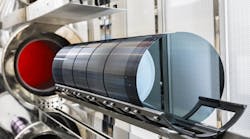Peregrine Semiconductor, which has long fabricated wireless chips out of painstakingly prepared silicon instead of compound semiconductors, changed its name Wednesday to pSemi. The company also said that it would continue to funnel its growing portfolio of products into fast growing markets like electric vehicles and factory equipment.
The company’s new name underlines its growing responsibility under Murata, which acquired it three years ago. The business unit consolidates Peregrine’s wireless devices, antenna tuners, power management, optical transceivers, and other chips. Murata packages these chips into various modules, which cut costs and save space in industrial and consumer electronics.
“We’ve challenged the pSemi team to broaden their scope, increase their intellectual property portfolio and grow on a global scale to support more semiconductor innovations,” said Norio Nakajima, senior executive vice president of Murata’s module business unit, in a statement. “pSemi will serve as the hub for Murata's semiconductor activities.”
Nakajima added that “we are investing in its aggressive growth strategy to fuel our move into more advanced and intelligent modules.” Murata said that it would support pSemi in hiring engineers and other professionally globally. Last year, Peregrine started to recruit for an engineering outpost in Texas and also bought power management chip maker Arctic Sand.
The San Diego Union-Tribute reports that Peregrine has 525 employees globally and that it plans to increase its work force by 10% in 2018.
Peregrine has shipped more than four billion chips in the three decades since its founders pioneered the use of silicon-on-insulator technology in wireless chips. The SOI wafers used in manufacturing Peregrine’s chips have a layer of silicon fastened onto an insulator – usually either sapphire or silicon dioxide – that improves performance, linearity, and power efficiency.
That way, Peregrine can fabricate smaller and cheaper chips by integrating amplifiers, switches and filters into the same wireless front ends in smartphones and other devices. Or it can squeeze more components into the same space to handle the growing number of frequency bands used in communications. Peregrine can also put microcontrollers and power management on the same die.
The company’s UltraCMOS platform provides integration not possible with compound semiconductors like gallium arsenide, which is widely used in high frequency electronics. Peregrine is trying to tip the scales to mount a challenge to Qorvo and Qualcomm, which has targeted switches and filters to surround its wireless modems for phones.
The rebranding follows other changes inside Peregrine, whose executive ranks have been reshaped over the last year. Almost a year ago, it hired Stefan Wolff, the former head of Intel’s mobile communications business, to be its chief executive. James Cable, the former chief, became global director of research and development for Murata.
Other hires have filled out the lower levels of the corporate pyramid. In August, Peregrine promoted Keith Bargoff to vice president of engineering and hired Sumit Tomar, a former general manager of Qorvo’s wireless infrastructure business, who became vice president of product marketing. These were both new leadership positions.
Dylan Kelly assumed the chief operating officer role in March 2017 after six years as general manager of Peregrine's mobile wireless solutions business. He said that Peregrine’s growing roster of engineers and products required a new leadership structure. The hires were among the biggest changes within Peregrine since Murata’s $471 million acquisition in 2014.








